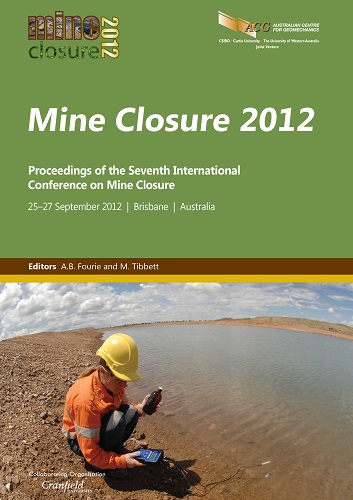Mine waste cover system design – considerations for cold regions

|
Authors: Dobchuk, B; Nahir, M; O’Kane, MA; Ayres, B |
DOI https://doi.org/10.36487/ACG_rep/1208_37_Dobchuk
Cite As:
Dobchuk, B, Nahir, M, O’Kane, MA & Ayres, B 2012, 'Mine waste cover system design – considerations for cold regions', in AB Fourie & M Tibbett (eds), Mine Closure 2012: Proceedings of the Seventh International Conference on Mine Closure, Australian Centre for Geomechanics, Perth, pp. 417-431, https://doi.org/10.36487/ACG_rep/1208_37_Dobchuk
Abstract:
The contaminated sites program of Aboriginal Affairs and Northern Development Canada (AANDC) is responsible for closure of contaminated sites on Crown land throughout the Canadian north. A significant percentage of the closure liabilities faced by AANDC are associated with abandoned mines. Of these mine-related liabilities, many involve the need to construct earthen cover systems over potentially reactive tailings and waste rock in cold regions. AANDC will be implementing cover systems at sites in the very near future and therefore require that critical questions in regards to cold regions cover systems be addressed: i) what are the key processes that will affect performance of different types of cover systems within a cold regions context; ii) how should the design process incorporate these issues; and iii) what are the risks to long-term performance as a result of these cold regions phenomena. This paper outlines the technical guidance approach for cover systems in cold regions that has been developed by AANDC with the assistance of a Technical Advisory Group (TAG). Extreme climatic conditions in cold regions result in the ground surface reacting in ways not experienced in warmer regions of the world. These terrain features are caused by frost action processes. Frost action refers to soil behaviours that are the result of freezing and thawing of water within the soil matrix. Key points from the guidance document are presented. Cover system design philosophy as it relates to cold regions is discussed including utilising attributes of cold regions in design. Designing for sustainability highlights the importance of final landform design and key failure mechanisms for covers in cold regions: thermokarst, solifluction, and glaciation of surface water management systems. An emphasis is placed on robust landform design as well as the importance of risk assessment to evaluate final cover design. A generic case study is presented to provide an example of a cold regions cover design and the results of a risk assessment.
References:
Andersland, O.B. and Ladanyi, B. (2004) Frozen Ground Engineering. Hoboken, New Jersey, John Wiley & Sons, Inc., pp. 363.
Ayres, B., Dobchuk, B., Christensen, D., O’Kane, M. and Fawcett, M. (2006) Incorporation of natural slope features into the design of final landforms for waste rock stockpiles, in Proceedings 7th International Conference for Acid Rock Drainage, 26–30 March, St. Louis, MO, USA, pp. 59–75.
Carey, S.K. and Woo, M.K. (2001) Spatial variability of hillslope water balance, Wolf Creek basin, subarctic Yukon, Hydrological Processes 15: 3113–3132.
Elshorbagy, A. and Barbour, S.L. (2006) Risk and uncertainty-based assessment of the hydrologic performance of reconstructed watersheds. Paper submitted to ASCE Journal of Geotechnical and Geoenvironmental Engineering (under review).
MEND 1.61.5a (2009) Mine waste covers in cold regions, Mine Environmental Neutral Drainage (MEND) Program, March 2009.
MEND 1.61.5b (2010) Cold regions cover research – Phase 2, Mine Environmental Neutral Drainage (MEND) Program, November 2010.
MEND 2.21.4 (2004) Design, construction and performance monitoring of cover systems for waste rock and tailings, Mine Environmental Neutral Drainage (MEND) Program, July 2004.
MEND 2.21.5 (2007) Macro-scale cover design and performance monitoring reference manual, Mine Environmental Neutral Drainage (MEND) Program, July 2007.
Norman, D.K., Wampler, P.J., Throop, A.H., Schnitzer, E.F., and Roloff, J.M. (1997) Best management practices for reclaiming surface mines in Washington and Oregon. Washington Division of Geology and Earth Resources, Open File Report 96-2, Revised Edition December 1997.
Robertson, A. and Shaw, S. (2006) Mine Closure, InfoMine E-Book, viewed 2 September 2010, 02 Mine Closure.pdf.
Washburn, A.L. (1973) Periglacial processes and environments, Edward Arnold Ltd, London, England, 320 p.
Yamazaki, T., Nishida, A. and Kondo, J. (1998) Seasonal frost depth of grounds with the bare surface, snow cover and vegetation, Journal of Japanese Society of Snow and Ice, Vol. 60, pp. 213–224 (in Japanese with English summary).
Zhang, Y., Carey, S.K. and Quinton, W.L. (2008) Evaluation of the algorithms and parameterizations for ground thawing and freezing simulation in permafrost regions, Journal of Geophysical Research, Vol. 113, D17116, .
© Copyright 2025, Australian Centre for Geomechanics (ACG), The University of Western Australia. All rights reserved.
View copyright/legal information
Please direct any queries or error reports to repository-acg@uwa.edu.au
View copyright/legal information
Please direct any queries or error reports to repository-acg@uwa.edu.au